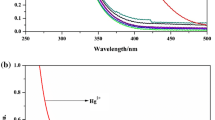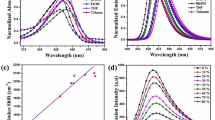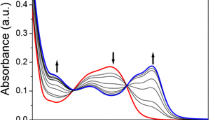Abstract
A new phenothiazine-thiophene hydrazone based ((10-ethyl-10H-phenothiazine-3,7-diyl)bis(methanylylidene))bis(thiophene-2-carbohydrazide) (PHT) chemosensor was synthesized via a single-step reaction and utilized as fluorescence “On-Off” sensor towards Hg2+ ion. The PHT was fully characterized by FT-IR, 1H-NMR, and ESI-Mass spectral analysis. The PHT probe was efficiently used for the selective detection of Hg2+ ion in the presence of other metal ions. Further, the stoichiometry of the PHT with Hg2+ complex was confirmed by Job’s plot analysis. The limit of detection (LOD) value of the probe PHT was found to be 0.44 × 10−8 M.
Graphical abstract












Similar content being viewed by others
Data Availability
The supporting information is available on the Springer publication website.
References
Kim HN, Ren WX, Kim JS, Yoon J (2012) Fluorescent and colorimetric sensors for detection of lead, cadmium, and mercury ions. Chem Soc Rev 41:3210–3244
Liu YL, Sun Y, Du J, Lv X, Zhao Y, Chen ML, Wang P, Guo W (2011) Highly sensitive and selective turn-on fluorescent and chromogenic probe for Cu2+ and ClO− based on a N-picolinyl rhodamine B-hydrazide derivative. Org Biomol Chem 9:432–437
Zou Q, Jin JY, Xu B, Ding L, Tian H (2011) New photochromic chemosensors for Hg2+ and F−. Tetrahedron 67:915–921
Singh AP, Murale DP, Ha Y, Liew H, Lee KM, Segev A, Suh Y, Churchill DG (2013) A novel, selective, and extremely responsive thienyl-based dual fluorogenic probe for tandem superoxide and Hg2+ chemosensing. Dalton Trans 42:3285–3290
Weng J, Mei Q, Zhang B, Jiang Y, Tong B, Fan Q, Ling Q, Huang W (2013) Multi-functional fluorescent probe for Hg2+, Cu2+ and ClO− based on a pyrimidin-4-yl phenothiazine derivative. Analyst 138:6607–6616
Martinez R, Espinosa A, Tarraga A, Molina P (2005) New Hg2+ and Cu2+ selective chromo- and fluoroionophore based on a bichromophoric azine. Org Lett 7:5869–5872
Goswami S, Maity S, Maity AC, Das AK, Pakhira B, Khanra K, Bhattacharyya N, Sarkar S (2015) ESIPT based Hg2+ and fluoride chemosensor for sensitive and selective ‘turn on’ red signal and cell imaging. RSC Adv 5:5735–5740
Zhang H, Huang Z, Feng G (2016) Colorimetric and ratiometric fluorescent detection of bisulfite by a new HBT-hemicyanine hybrid. Anal Chim Acta 920:72–79
Peng MJ, Yang XF, Yin B, Guo Y, Suzenet F, En D, Li J, Li CW, Duan YW (2014) A hybrid coumarin-thiazole fluorescent sensor for selective detection of bisulfite anions in vivo and in real samples. Chem Asian J 9:1817–1822
Zhang Q, Zhang Y, Ding S, Zhang H, Feng G (2015) A near-infrared fluorescent probe for rapid, colorimetric and ratiometric detection of bisulfite in food, serum, and living cells. Sensors Actuators B Chem 211:377–384
Wang J, Long L, Xiao X (2016) A fast-responsive fluorescent probe for sulfite and its bioimaging. Luminescence 31:775–781
Mishra J, Kaur H, Ganguli AK, Kaur N (2018) Fluorescent chemosensor based on urea/thiourea moiety for sensing of hg(II) ions in an aqueous medium with high sensitivity and selectivity: a comparative account on effect of molecular architecture on chemosensing. J Mol Struct 1161:34–43
Culzoni MJ, Munoz de la Pena A, Machuca A, Goicoechea HC, Babiano R (2013) Rhodamine and BODIPY chemodosimeters and chemosensors for the detection of Hg2+, based on fluorescence enhancement effects. Anal Methods 5:30–49
Ware GW, Ed, Mercury (1989) USEPA Office of Drinking Water health advisories. Rev Environ Contam Toxicol 107: 93–102
Harris HH, Pickering IJ, George GN (2003) The chemical form of mercury in fish. Science 301:1203
Gutknecht J (1981) Inorganic mercury (Hg2+) transport through lipid bilayer membranes. J Membr Biol 61:61–66
Bhattacharjee Y, Chakraborty A (2014) Label-free cysteamine-capped silver nanoparticle-based colorimetric assay for hg(II) detection in water with subnanomolar exactitude. ACS Sustain Chem Eng 2:2149–2154
Senser G, Uzun L, Denizli A (2014) Lysine-promoted colorimetric response of gold nanoparticles: a simple assay for ultrasensitive mercury(II) detection. Anal Chem 86:514–520
Bettini S, Pagano R, Valli L, Giancane G (2014) Spectroscopic investigation of the selective interaction of mercuric and cupric ions with a porphyrin active layer. J Phys Chem C 118:12384–12390
Jiang XJ, Fu Y, Tang H, Zang SQ, Hou HW, Mak TCW, Zhang HY (2014) A new highly selective fluorescent sensor for detection of Cd2+ and Hg2+ based on two different approaches in aqueous solution. Sensors Actuators B Chem 190:844–850
Alfonso M, Tarraga A, Molina P (2011) Ferrocene-based heteroditopic receptors displaying high selectivity toward lead and mercury metal cations through different channels. J Organomet Chem 76:939–947
Alfonso M, Tarraga A, Molina P (2010) Ferrocene-based multichannel molecular chemosensors with high selectivity and sensitivity for Pb(II) and hg(II) metal cations. Dalton Trans 39:8637–8645
Huang W, Zhu X, Wua DY, He C, Hu XY, Duan CY (2009) Structural modification of rhodamine-based sensors toward highly selective mercury detection in mixed organic/aqueous media. Dalton Trans 38:10457–10465
Fang CL, Zhou J, Liu XJ, Cao ZH, Shangguan DH (2011) Mercury(II)-mediated formation of imide-hg-imide complexes. Dalton Trans 40:899–903
Atilgan S, Kutuk I, Ozdemir T (2010) A near IR di-styryl BODIPY-based ratiometric fluorescent chemosensor for hg(II). Tetrahedron Lett 51:892–894
Mitra A, Mittal AK, Rao CP (2011) Carbohydrate assisted fluorescence turn-on gluco-aimino-anthracenyl conjugate as a hg(II) sensor in milk and blood serum milieu. Chem Commun 47:2565–2567
Pan J, Tang F, Ding A, Kong L, Yang L, Tao X, Tian Y, Yang J (2015) A small-molecule chemosensor for the selective detection of 2,4,6-trinitrophenol (TNP). RSC Adv 5:191–195
Sailer M, Franz AW, Műller TJJ (2008) Synthesis and electronic properties of monodisperse oligophenothiazines. Chem Eur J 14:2602–2614
Park MJ, Lee J, Park JH, Lee SK, Lee JL, Chu HY, Hwang DH, Shim HK (2008) Synthesis and electroluminescence of new polyfluorene copolymers with phenothiazine derivative. Their application in white-light-emitting diodes Macromolecules 41:3063–3070
Bieliauskas A, MartynaitisV GV, Malinauskas T, Jankauskas V, Kamarauskas E, Holzer W, Sackus A (2012) Synthesis of electroactive hydrazones derived from 3-(10-alkyl-10H-phenothiazin-3-yl)-2-propenals and their corresponding 3,3′-bispropenals. Tetrahedron 68:3552–3559
Weiss DS, Abkowitz M (2010) Advances in organic photoconductor technology. Chem Rev 110:479–526
Lygaitis R, Getautis V, Grazulevicius V (2008) Hole-transporting hydrazones. J Chem Soc Rev 37:770–788
Yang W, Yang S, Guo Q, Zhang T, Wu K, Hu Y (2015) Phenothiazine-aminothiourea-hg(II) ensemble-based fluorescence turn-on toward iodide in aqueous media and imaging application in live cells. Sensors Actuators B Chem 213:404–408
Muthu Vengaian K, Denzil Britto C, Sekar K, Sivaraman G, Singaravadivel S (2016) Phenothiazine-diaminomalenonitrile based colorimetric and fluorescence “turn-off-on” sensing of Hg2+ and S2−. Sensors Actuators B Chem 235:232–240
Frisch MJ, Trucks GW, Schlegel HB, Scuseria GE, Robb MA, Cheeseman JR, Scalmani G, Barone V, Mennucci B, Petersson GA, Nakatsuji H, Caricato M, Li X, Hratchian HP, Izmaylov AF, Bloino J, Zheng G, Sonnenberg JL, Hada M, Ehara M, Toyota K, Fukuda R, Hasegawa J, Ishida M, Nakajima T, Honda Y, Kitao O, Nakai H, Vreven T, Montgomery JA Jr, Peralta JE, Ogliaro F, Bearpark MJ, Heyd J, Brothers EN, Kudin KN, Staroverov VN, Kobayashi R, Normand J, Raghavachari K, Rendell AP, Burant JC, Iyengar SS, Tomasi J, Cossi M, Rega N, Millam NJ, Klene M, Knox JE, Cross JB, Bakken V, Adamo C, Jaramillo J, Gomperts R, Stratmann RE, Yazyev O, Austin AJ, Cammi R, Pomelli C, Ochterski JW, Martin RL, Morokuma K, Zakrzewski VG, Voth GA, Salvador P, Dannenberg JJ, Dapprich S, Daniels AD, Farkas JBF, Ortiz JV, Cioslowski J, Fox DJ (2009) Gaussian 09, Vol. Gaussian, Inc., Wallingford, CT, USA
Acknowledgments
The authors are grateful for the financial support from the University Grants Commission, (UGC-BSR, NO: F. 30-319/2016) Government of India, New Delhi, India. The first author acknowledges Periyar University, Salem, Tamilnadu for providing University Research Fellowship (URF).
Funding
This Study Was Supported by the University Grants Commission - Basic Scientific Research (UGC-BSR) Fund, Government of India
Author information
Authors and Affiliations
Contributions
Not Applicable.
Corresponding authors
Ethics declarations
Conflicts Interest
There is no conflict to declare.
Additional information
Publisher’s Note
Springer Nature remains neutral with regard to jurisdictional claims in published maps and institutional affiliations.
Supplementary Information
ESM 1
(DOC 420 kb)
Rights and permissions
About this article
Cite this article
Govindasamy, V., Perumal, S., Sekar, I. et al. Phenothiazine-Thiophene Hydrazide Dyad: An Efficient “On-Off” Chemosensor for Highly Selective and Sensitive Detection of Hg2+ Ions. J Fluoresc 31, 667–674 (2021). https://doi.org/10.1007/s10895-021-02690-8
Received:
Accepted:
Published:
Issue Date:
DOI: https://doi.org/10.1007/s10895-021-02690-8




